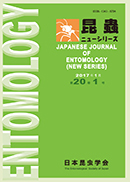Volume 7, Issue 2
Displaying 1-17 of 17 articles from this issue
- |<
- <
- 1
- >
- >|
-
Article type: Cover
2004 Volume 7 Issue 2 Pages Cover1-
Published: June 25, 2004
Released on J-STAGE: September 21, 2018
Download PDF (14K) -
Article type: Appendix
2004 Volume 7 Issue 2 Pages App1-
Published: June 25, 2004
Released on J-STAGE: September 21, 2018
Download PDF (59K)
-
Article type: Article
2004 Volume 7 Issue 2 Pages 39-54
Published: June 25, 2004
Released on J-STAGE: September 21, 2018
Download PDF (3348K) -
Article type: Article
2004 Volume 7 Issue 2 Pages 55-68
Published: June 25, 2004
Released on J-STAGE: September 21, 2018
Download PDF (1329K) -
Article type: Article
2004 Volume 7 Issue 2 Pages 69-71
Published: June 25, 2004
Released on J-STAGE: September 21, 2018
Download PDF (316K) -
Article type: Article
2004 Volume 7 Issue 2 Pages 73-78
Published: June 25, 2004
Released on J-STAGE: September 21, 2018
Download PDF (1340K)
-
Article type: Article
2004 Volume 7 Issue 2 Pages 72-
Published: June 25, 2004
Released on J-STAGE: September 21, 2018
Download PDF (181K) -
Article type: Article
2004 Volume 7 Issue 2 Pages 79-
Published: June 25, 2004
Released on J-STAGE: September 21, 2018
Download PDF (152K) -
Article type: Article
2004 Volume 7 Issue 2 Pages 80-
Published: June 25, 2004
Released on J-STAGE: September 21, 2018
Download PDF (234K) -
Article type: Bibliography
2004 Volume 7 Issue 2 Pages 81-84
Published: June 25, 2004
Released on J-STAGE: September 21, 2018
Download PDF (374K) -
Article type: Appendix
2004 Volume 7 Issue 2 Pages 87-89
Published: June 25, 2004
Released on J-STAGE: September 21, 2018
Download PDF (177K) -
Article type: Appendix
2004 Volume 7 Issue 2 Pages App2-
Published: June 25, 2004
Released on J-STAGE: September 21, 2018
Download PDF (71K) -
Article type: Appendix
2004 Volume 7 Issue 2 Pages App3-
Published: June 25, 2004
Released on J-STAGE: September 21, 2018
Download PDF (71K) -
Article type: Appendix
2004 Volume 7 Issue 2 Pages App4-
Published: June 25, 2004
Released on J-STAGE: September 21, 2018
Download PDF (71K) -
Article type: Appendix
2004 Volume 7 Issue 2 Pages App5-
Published: June 25, 2004
Released on J-STAGE: September 21, 2018
Download PDF (71K) -
Article type: Cover
2004 Volume 7 Issue 2 Pages Cover2-
Published: June 25, 2004
Released on J-STAGE: September 21, 2018
Download PDF (46K) -
Article type: Cover
2004 Volume 7 Issue 2 Pages Cover3-
Published: June 25, 2004
Released on J-STAGE: September 21, 2018
Download PDF (46K)
- |<
- <
- 1
- >
- >|
